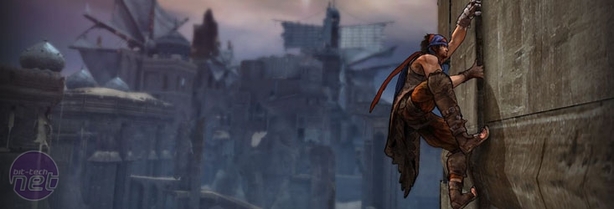
Impressions
One aspect we haven’t yet touched upon though is the platforming element of Prince of Persia, which we’ve done purely for the reason that mercifully nothing much has changed from the previous games in the series.The Prince is still as athletic and acrobatic as he always was and is still able to run along walls, vault over chasms and swing from poles with a reckless and almost gleeful defiance for gravity. That’s all same old, same old.
What has changed is his repertoire of moves, as the new Prince is equipped with all new moves and techniques. Not only can the Prince combine his moves more fluidly than ever, but he can also pull off some all new ones.
Some of these moves you’ll probably have seen already, like when he grips his armoured glove into a wall and slides down the surface. Others you won’t, like when he uses the glove to scurry across ceilings and around rocky overhangs.
Not all of these moves are totally believable obviously, but all of them are superbly animated and look more fluid and smooth than an ebbing oil-slick, minus the deathly toll on the sea-life. Obviously.
What’s more, Elika can play a part in these platforming sections too. Sometimes her involvement is automatic and if you miss a jump in the game then you can nearly always rely on her glowing hand to shoot down and save you. That’s not something we totally like admittedly and while we understand that the game is using Elika to replace the rewind-feature that made the previous games so accessible and fun, we also think it makes the game a bit too easy at points.
What’s likely to be Elika’s most often used ability though is the boost jump, where Elika will jump into the air after the Prince and use her magic to fling them both up, up and away. It’s a move Elika can do from certain platforms to launch her and the Prince to certain, far away locations or from a normal running leap if the Prince needs to jump further than normal.
So, the combat is good and the platforming is good and the fact that you can talk to Elika (or yourself) whenever you want is good too. It’s all good.
One thing that stood out to us about Prince of Persia though, aside from the fantastic level design which showcases the sheer fantasy of the Prince’s world and how it intersects with the natural beauty around all of us, was the way that all these elements work together. It’s seamless and the combined result of this carefully measured dialogue, drama, beauty and action is both utterly shocking and totally harmonious.
At its most obvious, this harmony shows itself on the micro level. We can look at the Prince and just see how this character – this man – will behave. Straight away we can recognise how he’s simultaneously both noble and selfish, naïve and cautious. We see how he’s a force for good and a force for nothing; the type of man who’d go bar-brawling for fun but would also fiercely defend those who need it.
Slightly harder to see though is the level above this; the macro level where the Prince’s character is just a small piece which slots into a much bigger puzzle. In our brief time with the game we only got a small taste of all that – but we liked it. The sounds, sights and feel of the game all pull together perfectly to make a fantasy world that’s so lifelike and colourful that you can almost hear it breathing.
The Prince isn’t just a man of the world, he’s a man of his world and it is a world we just can’t wait to go leaping back into.
Prince of Persia is out December this year on the Xbox 360, PlayStation 3 and PC. There's also a DS version coming out too, called Prince of Persia: The Fallen King. In the meantime why don't you let us know what you think of the new direction the game is taking in the forums?

MSI MPG Velox 100R Chassis Review
October 14 2021 | 15:04











Want to comment? Please log in.